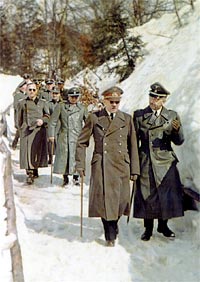| Sunday 11 February 2001
Germany
turns the relics of its Nazi past over to
tourism By Allan Hall in Berlin BUILDINGS used by the
officers at the notorious female
concentration camp of Ravensbruck - where
Anne Frank died - are being
converted into a youth hostel and an
educational institute.  The
project is the latest in the past 12
months in which many of the Third Reich's
most infamous sites have been transformed
into tourism or leisure venues as Germany
seeks to draw a line under its past.
Germans are queuing up for a glimpse of a
time that has been buried beneath layers
of guilt, uncertainty and shame. The
project is the latest in the past 12
months in which many of the Third Reich's
most infamous sites have been transformed
into tourism or leisure venues as Germany
seeks to draw a line under its past.
Germans are queuing up for a glimpse of a
time that has been buried beneath layers
of guilt, uncertainty and shame.
While Hitler and his legacies will
never beat Euro Disney as the holiday
destination of choice, there is a quiet
but defineable determination within the
German psyche to visit the places where
the madness was spawned and to understand
it. Ravensbruck, 50 miles north of Berlin,
where the teenage diarist Anne Frank died
along with as many as 92,000 other female
and child inmates including the British
SOE agent Violette Szabo, was
earmarked for change last month. Eight of
the 23 former SS guardhouses will be
converted to cater for an estimated 13,000
visitors each year. The money will come from the European
Union, the German Youth Hostel Association
and the local state government of
Brandenburg. Günter Morsch,
the head of the foundation behind the
conversion, said he found it fitting for
the new role for the buildings in this
year of rising neo-Nazi violence in
Germany. The aim is to open the
accommodation on
April 20,
2002, the 57th anniversary of the camp's
liberation by the Red Army. Ravensbruck is but one Nazi site among
many that has been or is about to be
transformed for "educational tourism".
After the war many buildings which
represented the monstrosity of National
Socialism were destroyed. The Allies had a
dual motive for this: to erase the memory
of Nazism and to prevent "shrines"
developing in the future - an idea that
persisted for decades.  The
Berghof
[left],
Hitler's
mountain home in Bavaria, was destroyed in
1945 as was Spandau prison in the late
1980s after the last inmate, Hitler's
deputy Rudolf Hess, died. In the
past year, however, many other sites of
importance in the Third Reich have become
tourist magnets. The
Berghof
[left],
Hitler's
mountain home in Bavaria, was destroyed in
1945 as was Spandau prison in the late
1980s after the last inmate, Hitler's
deputy Rudolf Hess, died. In the
past year, however, many other sites of
importance in the Third Reich have become
tourist magnets.
The German acceptance, and sometime
embrace, of its monstrous past is seen as
a sign of maturity by historians and
academics. Several weeks ago record
numbers of German television viewers tuned
in to a domestically made documentary on
the Holocaust, a programme unthinkable
just a few years ago. Last summer, thousands of people
traipsed through a new museum carved in
the air-raid tunnels of the Kehlstein, the
mountain at Berchtesgaden where Hitler had
his summer residence. Four hundred miles north, 35 miles from
the centre of Berlin, a more alfresco
pursuit takes place in a wood where once
stood the ostentatious hunting lodge of
Karinhall, the country seat of Hermann
Goering - the Luftwaffe chief and art
thief extraordinaire. Amateur treasure
hunters rake the ground each weekend for
lost artefacts. Further north, on the Baltic island of
Rugen, lie the four miles of seafront
flats that Hitler built for his disciples
at Prora as the biggest holiday camp in
the world. It was never used - holidays
were cancelled after the invasion of
Poland and the start of the Second World
War. Prora has become a tourist attraction
in its own right while work begins to turn
the flats into fashionable apartments. In Berlin, the subterranean
constructions of the National Socialists
now pull in huge crowds. For every foot of
building above ground in the German
capital, there are three below; secret
tunnels and bunkers begun when Hitler came
to power in 1933. At Gesundbrunnen in the
working-class district of Wedding, a
resolute band of weekend enthusiasts
opened up an air raid bunker and tunnel
complex.  Above ground there are walking tours
that take in the architecture of the Third
Reich; Goering's Luftwaffe ministry, the
sweeping lines of Tempelhof Airport -
still one of the largest interior spaces
in the world - and the Topography of
Terror, a words-and-pictures exhibition
set against the ruins of the Gestapo
building. Every day thousands of people visit the
former secret police headquarters at 8,
Prinz Albrecht Strasse, once the most
feared address in Europe, or travel south
to the beautiful lake at Wannsee
[Haus am
Wannsee, right; click for Wannsee
conference index] where
Hitler's Final  Solution
for the extermination of the Jews was
decided. Along the Baltic coastline, the
government is investing £3 million in
a new museum and tourist centre at the
site of the V1 and V2 rocket launch
pads. Solution
for the extermination of the Jews was
decided. Along the Baltic coastline, the
government is investing £3 million in
a new museum and tourist centre at the
site of the V1 and V2 rocket launch
pads. Related
items on this website:  Anne
Frank index (she died of typhus at
Bergen Belsen, not Ravensbruck) Anne
Frank index (she died of typhus at
Bergen Belsen, not Ravensbruck)
|